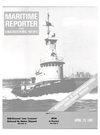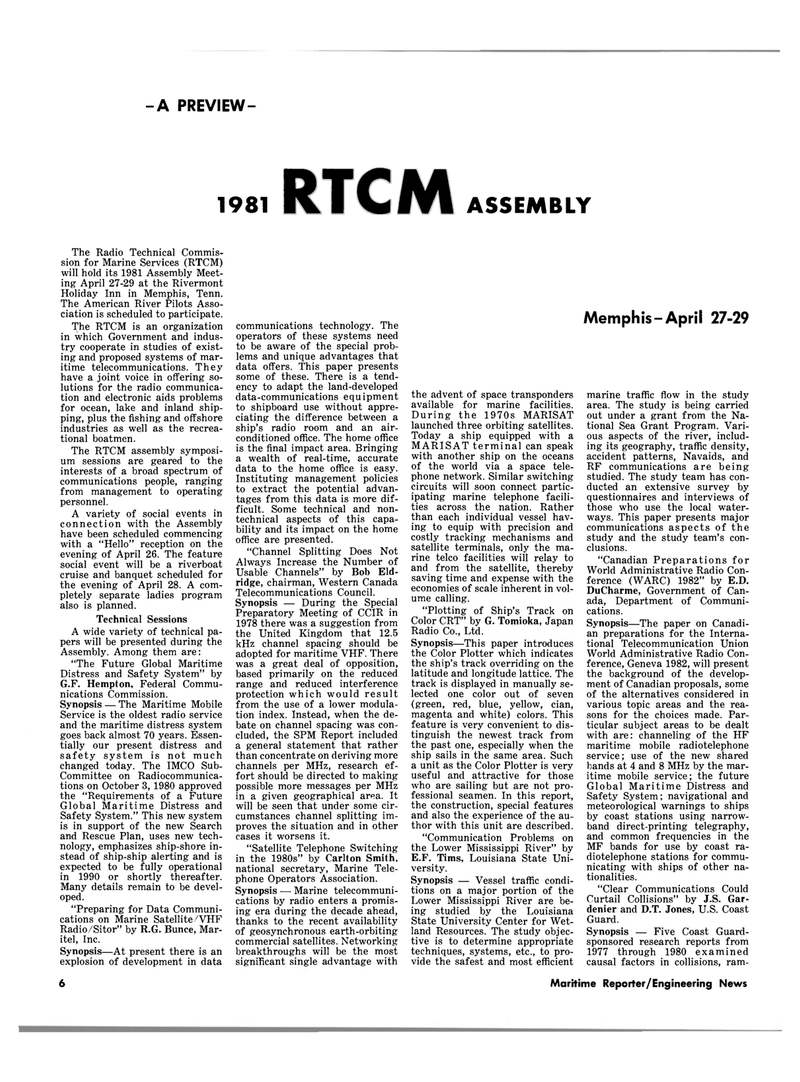
Page 4: of Maritime Reporter Magazine (April 15, 1981)
Read this page in Pdf, Flash or Html5 edition of April 15, 1981 Maritime Reporter Magazine
-A PREVIEW - 1981 RTCM ASSEMBLY
The Radio Technical Commis- sion for Marine Services (RTCM) will hold its 1981 Assembly Meet- ing April 27-29 at the Rivermont
Holiday Inn in Memphis, Tenn.
The American River Pilots Asso- ciation is scheduled to participate.
The RTCM is an organization in which Government and indus- try cooperate in studies of exist- ing and proposed systems of mar- itime telecommunications. They have a joint voice in offering so- lutions for the radio communica- tion and electronic aids problems for ocean, lake and inland ship- ping, plus the fishing and offshore industries as well as the recrea- tional boatmen.
The RTCM assembly symposi- um sessions are geared to the interests of a broad spectrum of communications people, ranging from management to operating personnel.
A variety of social events in connection with the Assembly have been scheduled commencing with a "Hello" reception on the evening of April 26. The feature social event will be a riverboat cruise and banquet scheduled for the evening of April 28. A com- pletely separate ladies program also is planned.
Technical Sessions
A wide variety of technical pa- pers will be presented during the
Assembly. Among them are: "The Future Global Maritime
Distress and Safety System" by
G.F. Hempton, Federal Commu- nications Commission.
Synopsis — The Maritime Mobile
Service is the oldest radio service and the maritime distress system goes back almost 70 years. Essen- tially our present distress and safety system is not much changed today. The IMCO Sub-
Committee on Radiocommunica- tions on October 3, 1980 approved the "Requirements of a Future
Global Maritime Distress and
Safety System." This new system is in support of the new Search and Rescue Plan, uses new tech- nology, emphasizes ship-shore in- stead of ship-ship alerting and is expected to be fully operational in 1990 or shortly thereafter.
Many details remain to be devel- oped. "Preparing for Data Communi- cations on Marine Satellite/VHF
Radio/Sitor" by R.G. Bunce, Mar- itel, Inc.
Synopsis—At present there is an explosion of development in data communications technology. The operators of these systems need to be aware of the special prob- lems and unique advantages that data offers. This paper presents some of these. There is a tend- ency to adapt the land-developed data-communications equipment to shipboard use without appre- ciating the difference between a ship's radio room and an air- conditioned office. The home office is the final impact area. Bringing a wealth of real-time, accurate data to the home office is easy.
Instituting management policies to extract the potential advan- tages from this data is more dif- ficult. Some technical and non- technical aspects of this capa- bility and its impact on the home office are presented. "Channel Splitting Does Not
Always Increase the Number of
Usable Channels" by Bob Eld- ridge, chairman, Western Canada
Telecommunications Council.
Synopsis — During the Special
Preparatory Meeting of CCIR in 1978 there was a suggestion from the United Kingdom that 12.5 kHz channel spacing should be adopted for maritime VHF. There was a great deal of opposition, based primarily on the reduced range and reduced interference protection which would result from the use of a lower modula- tion index. Instead, when the de- bate on channel spacing was con- cluded, the SPM Report included a general statement that rather than concentrate on deriving more channels per MHz, research ef- fort should be directed to making possible more messages per MHz in a given geographical area. It will be seen that under some cir- cumstances channel splitting im- proves the situation and in other cases it worsens it. "Satellite Telephone Switching in the 1980s" by Carlton Smith, national secretary, Marine Tele- phone Operators Association.
Synopsis — Marine telecommuni- cations by radio enters a promis- ing era during the decade ahead, thanks to the recent availability of geosynchronous earth-orbiting commercial satellites. Networking breakthroughs will be the most significant single advantage with
Memphis-April 27-29 the advent of space transponders available for marine facilities.
During the 1970s MARISAT launched three orbiting satellites.
Today a ship equipped with a
MARISAT terminal can speak with another ship on the oceans of the world via a space tele- phone network. Similar switching circuits will soon connect partic- ipating marine telephone facili- ties across the nation. Rather than each individual vessel hav- ing to equip with precision and costly tracking mechanisms and satellite terminals, only the ma- rine telco facilities will relay to and from the satellite, thereby saving time and expense with the economies of scale inherent in vol- ume calling. "Plotting of Ship's Track on
Color CRT" by G. Tomioka, Japan
Radio Co., Ltd.
Synopsis—This paper introduces the Color Plotter which indicates the ship's track overriding on the latitude and longitude lattice. The track is displayed in manually se- lected one color out of seven (green, red, blue, yellow, cian, magenta and white) colors. This feature is very convenient to dis- tinguish the newest track from the past one, especially when the ship sails in the same area. Such a unit as the Color Plotter is very useful and attractive for those who are sailing but are not pro- fessional seamen. In this report, the construction, special features and also the experience of the au- thor with this unit are described. "Communication Problems on the Lower Mississippi River" by
E.F. Tims, Louisiana State Uni- versity.
Synopsis — Vessel traffic condi- tions on a major portion of the
Lower Mississippi River are be- ing studied by the Louisiana
State University Center for Wet- land Resources. The study objec- tive is to determine appropriate techniques, systems, etc., to pro- vide the safest and most efficient marine traffic flow in the study area. The study is being carried out under a grant from the Na- tional Sea Grant Program. Vari- ous aspects of the river, includ- ing its geography, traffic density, accident patterns, Navaids, and
RF communications are being studied. The study team has con- ducted an extensive survey by questionnaires and interviews of those who use the local water- ways. This paper presents major communications aspects of the study and the study team's con- clusions. "Canadian Preparations for
World Administrative Radio Con- ference (WARC) 1982" by E.D.
DuCharme, Government of Can- ada, Department of Communi- cations.
Synopsis—The paper on Canadi- an preparations for the Interna- tional Telecommunication Union
World Administrative Radio Con- ference, Geneva 1982, will present the background of the develop- ment of Canadian proposals, some of the alternatives considered in various topic areas and the rea- sons for the choices made. Par- ticular subject areas to be dealt with are: channeling of the HF maritime mobile radiotelephone service; use of the new shared bands at 4 and 8 MHz by the mar- itime mobile service; the future
Global Maritime Distress and
Safety System; navigational and meteorological warnings to ships by coast stations using narrow- band direct-printing telegraphy, and common frequencies in the
MF bands for use by coast ra- diotelephone stations for commu- nicating with ships of other na- tionalities. "Clear Communications Could
Curtail Collisions" by J.S. Gar- denier and D.T. Jones, U.S. Coast
Guard.
Synopsis — Five Coast Guard- sponsored research reports from 1977 through 1980 examined causal factors in collisions, ram- 6 Maritime Reporter/Engiineering News

 3
3

 5
5
